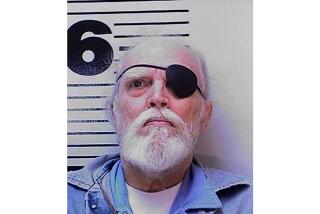DNA Evidence Links Convicted Sex Criminal to 1977 Rape-Slaying
New DNA technology has linked a Santa Ana sex criminal to the 1977 rape and slaying of a Bellflower woman who lived directly above his apartment, detectives said Tuesday.
Harry Lavon Rowley, a 45-year-old convicted rapist, will be arraigned today in Los Angeles County on charges that he strangled Pamela Sperry in December 1977, a crime that stymied investigators until samples of body fluid stored away for two decades were recently reexamined with the latest DNA technology.
Rowley, who lived in Sperryâs Bellflower apartment building at the time, was arrested weeks after Sperry was found strangled with a telephone cord, but a judge ruled there was not enough evidence to put him on trial for murder, rape and burglary. The evidence was filed away until it was dug out by Los Angeles County Sheriffâs investigator Louie Danoff, after Sperryâs family contacted him for an update on the case.
DNA tests were used to link the dated evidence in the earlier case to Rowley, who has denied wrongdoing. If convicted, Rowley could face the death penalty.
He was released from prison in February after serving a seven-year sentence for a series of Tustin rapes, and he was convicted of child molestation in 1983, records show.
He has been in a Bakersfield prison since his arrest in July for a parole violation.
The four-time felon is also being investigated now in the 1988 slaying of Rachael Sugarman, 37, who was strangled and set afire in her Tustin apartment, investigators said. Police declined Tuesday to call him a suspect, but they confirmed they will question him about the killing of the woman who lived near Rowleyâs then-residence in Tustin.
âThere are very strong similarities between our case and the Bellflower case,â Tustin investigator Tom Tarpley said, pointing out that both strangled women were neighbors of Rowley.
This year, Santa Ana police felt Rowley was too great a threat to his neighbors to allow him to live quietly in the 300 block of South Sullivan Street, so they put his name, photo and criminal record on handbills and sent them to neighbors and schools.
At the time, Rowley was one of seven sex criminals in the city to be publicized under Meganâs Law, which allows authorities to alert neighborhoods to sex criminals in their midst. Two weeks after the June announcements, Rowley was arrested by parole officers.
Witnesses told police they saw two men fleeing Sugarmanâs burning apartment. Investigators now suspect those men were Rowley and James Brandon, who also lived in the complex and has been considered a suspect, although he denied any involvement, Tarpley said.
Tustin investigators first focused on Brandon after a national bulletin named him as a suspect in a similar crime in Topeka, Kan., Tarpley said. The woman set on fire in that incident survived and identified Brandon, her then-boyfriend, as her attacker.
âObviously, that piqued our interest because both victims were set on fire, and then we learned that Brandon had lived within 100 yards of [Sugarman] at the time of her attack,â Tarpley said.
Tustin police found Brandon in 1996 and, after a high-speed chase that wound through Orange County and ended in Walnut, they arrested him and questioned him about Sugarmanâs slaying. But detectives failed to connect him to the crime, and Brandon was extradited to Kansas, where he was convicted of attempted murder.
More to Read
Sign up for Essential California
The most important California stories and recommendations in your inbox every morning.
You may occasionally receive promotional content from the Los Angeles Times.










